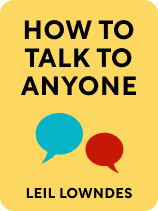

This article is an excerpt from the Shortform book guide to "How to Talk to Anyone" by Leil Lowndes. Shortform has the world's best summaries and analyses of books you should be reading.
Like this article? Sign up for a free trial here .
How do you establish rapport with someone? What are some rapport-building techniques you can use to instantly spark a connection?
Building rapport with people isn’t that difficult. You just have to put your conversation partners at ease and focus on making them feel as if you like them. Leil Lowndes suggests four techniques to achieve this: 1) use and take notice of visual gimmicks, 2) ask for introductions, 3) prepare stimulating answers to common questions, and 4) research interesting things to say in advance.
Here’s how to build rapport instantly, according to communications expert Leil Lowndes.
#1: Use and Take Notice of Visual Gimmicks
In her book How to Talk to Anyone, Leil Lowndes explains how to build rapport with anyone. The first step, she says is to use and take notice of visual gimmicks.
Lowndes suggests an easy way to start conversations: Draw attention to yourself by wearing or carrying something unusual, such as a unique brooch or a colorful shirt. This gives people an excuse to approach you and gives you something to talk about. Likewise, pay attention to what those around you are wearing or carrying so that you have an excuse to approach them. Using a complimentary phrase such as, “Wow, I love your shoes! Where are they from?” not only helps you to start a conversation, but it also shows others that you’re interested in them and what they have to say.
#2: Ask for Introductions
According to Lowndes, another effective way to approach new people is to ask mutual acquaintances to make introductions for you. Before they introduce you, ensure that they’ll pad out these introductions with a few details, such as the new person’s hobbies or interests so that you have the opportunity to show your interest and start a discussion.
Alternatively, if your acquaintances are too busy to introduce you, ask them for information so that you can find a shared interest to use as an icebreaker. With this information, you can easily approach someone new using a variation of the following line: “Hey, I was just talking to … and she told me that you …”
#3: Prepare Stimulating Responses to Common Questions
When people first meet each other, they usually ask two questions: “Where are you from?” and “What do you do?” Normally, they each respond with fact-based answers—for example, “I’m from New York and I’m an engineer.” But, Lowndes argues, this sort of answer shuts down a conversation—if your conversation partner’s never been to New York or knows nothing about engineering, they won’t know how to continue the conversation.
Instead, Lowndes suggests extending your responses to these two questions in a way that stimulates a response—by using interesting facts, jokes, or general observations. This requires coming up with different variations depending on who you’re talking to and the social context you’re in. If you’re seeking to make friends, keep your responses fun and general. For example, “I’m from X—where they make the best goat’s cheese in the world.” If you’re talking to them for networking purposes, consider what interest this person could have in you or your work and include that in your response. For example, “I’m an engineer and have been working on X for the past two years.”
#4: Research Interesting Things to Say in Advance
Once you’ve discussed where you’re from and what you do, you’ll need other topics to lure people into conversations and keep them engaged. Lowndes suggests four ways to prepare yourself for interesting conversations:
1) Find out who will be there: Before you accept an invitation, find out what type of people will be there—will it include people from a single profession or interest group? Knowing what types of conversations you’ll be expected to engage in will help you prepare for them.
2) Listen to the news: This will keep you up to date on current affairs and will provide common topics to discuss.
3) Continually try new activities: Restricting yourself to specific activities limits your ability to engage with people who have other interests. The more you try out or read about different activities, the easier you’ll find it to communicate with a wider range of people.
4) Broaden your vocabulary: In addition to researching things to say, think about how you say them. Make yourself sound more interesting by replacing your most common words with alternatives. Look through a thesaurus to find words that suit your personality and reflect how you want to come across to others.

———End of Preview———
Like what you just read? Read the rest of the world's best book summary and analysis of Leil Lowndes's "How to Talk to Anyone" at Shortform .
Here's what you'll find in our full How to Talk to Anyone summary :
- Practical techniques to help you overcome social discomfort
- How to confidently develop new connections
- How to appear more likable without saying a word






